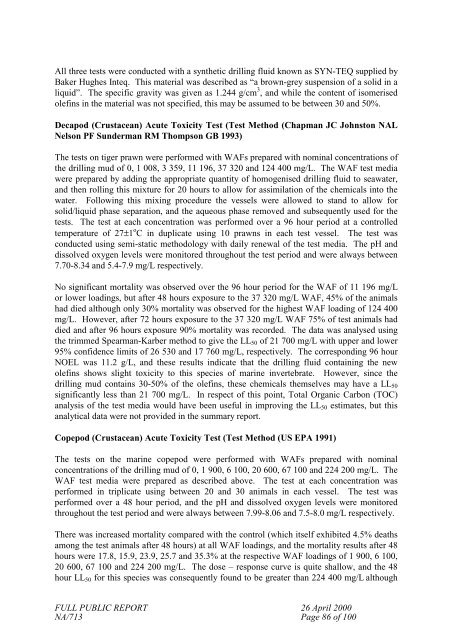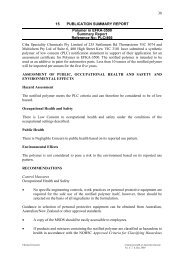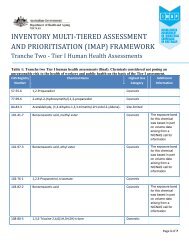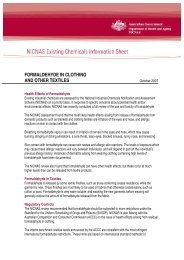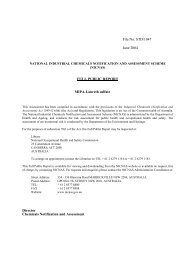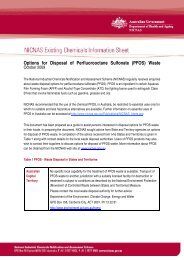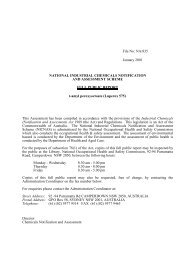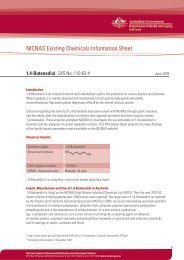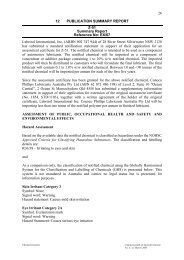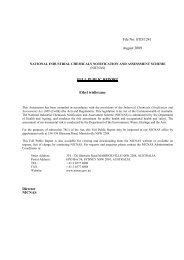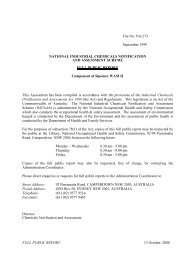GULFTENE C16-18 ISOMERISED OLEFINS - NICNAS
GULFTENE C16-18 ISOMERISED OLEFINS - NICNAS
GULFTENE C16-18 ISOMERISED OLEFINS - NICNAS
Create successful ePaper yourself
Turn your PDF publications into a flip-book with our unique Google optimized e-Paper software.
All three tests were conducted with a synthetic drilling fluid known as SYN-TEQ supplied by<br />
Baker Hughes Inteq. This material was described as “a brown-grey suspension of a solid in a<br />
liquid”. The specific gravity was given as 1.244 g/cm 3 , and while the content of isomerised<br />
olefins in the material was not specified, this may be assumed to be between 30 and 50%.<br />
Decapod (Crustacean) Acute Toxicity Test (Test Method (Chapman JC Johnston NAL<br />
Nelson PF Sunderman RM Thompson GB 1993)<br />
The tests on tiger prawn were performed with WAFs prepared with nominal concentrations of<br />
the drilling mud of 0, 1 008, 3 359, 11 196, 37 320 and 124 400 mg/L. The WAF test media<br />
were prepared by adding the appropriate quantity of homogenised drilling fluid to seawater,<br />
and then rolling this mixture for 20 hours to allow for assimilation of the chemicals into the<br />
water. Following this mixing procedure the vessels were allowed to stand to allow for<br />
solid/liquid phase separation, and the aqueous phase removed and subsequently used for the<br />
tests. The test at each concentration was performed over a 96 hour period at a controlled<br />
temperature of 27±1 o C in duplicate using 10 prawns in each test vessel. The test was<br />
conducted using semi-static methodology with daily renewal of the test media. The pH and<br />
dissolved oxygen levels were monitored throughout the test period and were always between<br />
7.70-8.34 and 5.4-7.9 mg/L respectively.<br />
No significant mortality was observed over the 96 hour period for the WAF of 11 196 mg/L<br />
or lower loadings, but after 48 hours exposure to the 37 320 mg/L WAF, 45% of the animals<br />
had died although only 30% mortality was observed for the highest WAF loading of 124 400<br />
mg/L. However, after 72 hours exposure to the 37 320 mg/L WAF 75% of test animals had<br />
died and after 96 hours exposure 90% mortality was recorded. The data was analysed using<br />
the trimmed Spearman-Karber method to give the LL50 of 21 700 mg/L with upper and lower<br />
95% confidence limits of 26 530 and 17 760 mg/L, respectively. The corresponding 96 hour<br />
NOEL was 11.2 g/L, and these results indicate that the drilling fluid containing the new<br />
olefins shows slight toxicity to this species of marine invertebrate. However, since the<br />
drilling mud contains 30-50% of the olefins, these chemicals themselves may have a LL50<br />
significantly less than 21 700 mg/L. In respect of this point, Total Organic Carbon (TOC)<br />
analysis of the test media would have been useful in improving the LL50 estimates, but this<br />
analytical data were not provided in the summary report.<br />
Copepod (Crustacean) Acute Toxicity Test (Test Method (US EPA 1991)<br />
The tests on the marine copepod were performed with WAFs prepared with nominal<br />
concentrations of the drilling mud of 0, 1 900, 6 100, 20 600, 67 100 and 224 200 mg/L. The<br />
WAF test media were prepared as described above. The test at each concentration was<br />
performed in triplicate using between 20 and 30 animals in each vessel. The test was<br />
performed over a 48 hour period, and the pH and dissolved oxygen levels were monitored<br />
throughout the test period and were always between 7.99-8.06 and 7.5-8.0 mg/L respectively.<br />
There was increased mortality compared with the control (which itself exhibited 4.5% deaths<br />
among the test animals after 48 hours) at all WAF loadings, and the mortality results after 48<br />
hours were 17.8, 15.9, 23.9, 25.7 and 35.3% at the respective WAF loadings of 1 900, 6 100,<br />
20 600, 67 100 and 224 200 mg/L. The dose – response curve is quite shallow, and the 48<br />
hour LL50 for this species was consequently found to be greater than 224 400 mg/L although<br />
FULL PUBLIC REPORT 26 April 2000<br />
NA/713 Page 86 of 100


